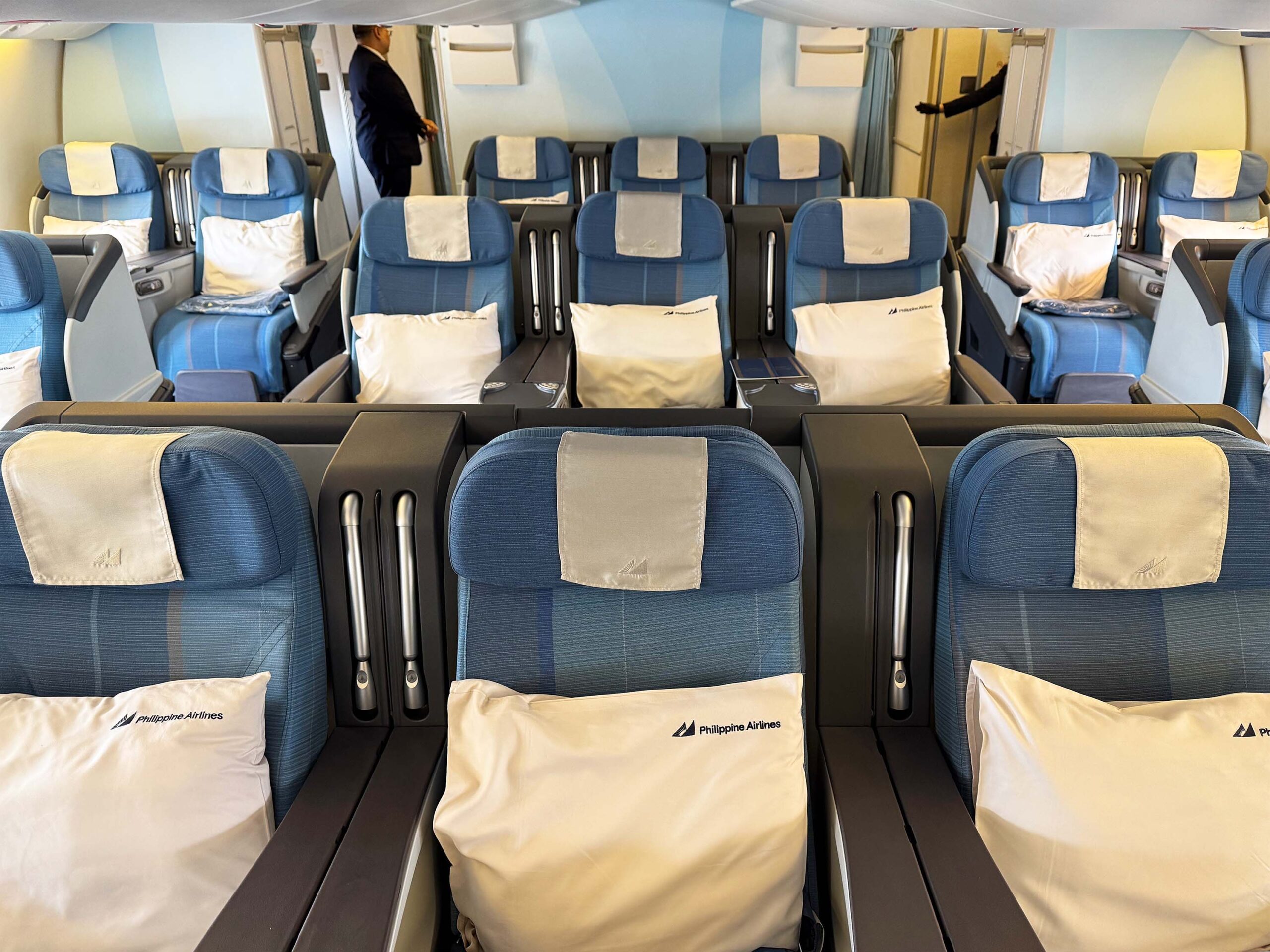
Philippine Airlines flight details
Airline : Philippine Airlines
Flight No : PR336
Departure City : Manila – Ninoy Aquino (MNL)
Arrival City : Shanghai – Pudong (PVG)
Equipment : Boeing 777-300ER (RP-C7773)
Blocked Time : 3h50m
Seat No: 2K
After spending about four hours in Manila, it was finally time to head to Shanghai! I was particularly excited for this flight as it was operated by a Boeing 777-300ER, which usually flies longer flights to Europe or North America; this would certainly be a contrast to the regional Airbus A321-200 I flew on my last flight! Or so I thought… Regardless, since this review is a continuation of my redeye flight from Jakarta, I will not be going over the check-in experience or the booking process again.
Lounge
At its hub in Terminal 1, Philippine Airlines operates its flagship Mabuhay Lounge. Opened in 2023, the lounge marked a notable shift for the airline, which historically outsourced its lounge services in Terminal 1 to third parties. While it doesn’t compare to the excellent Cathay Pacific Lounge Manila, for example, the lounge was quite nice and completely serviceable. I have reviewed the Mabuhay Lounge in a previous instalment, which you can read here.

Boarding
After spending roughly two hours at the Mabuhay Lounge, I headed for the gate early in hopes of being one of the first passengers to board the aircraft. Although boarding was scheduled for 09.50, 50 minutes before our scheduled departure time, I was surprised to see that boarding had already begun when I arrived at the gate area at 09.45.


After cross-checking my name against the passenger manifest, I was permitted into the holding pen, from where I quickly lined up to get on board our flight. Considering how crowded the gate was, I was thankful that most passengers were still sat instead of blocking the boarding queues.


At the door, I was greeted by Jan, who walked me to my seat and offered to help me store my belongings. What a nice gesture! At this point, Business Class was still relatively empty, perhaps because most people were still at the Mabuhay Lounge.
Philippines Airlines 777 cabin
Our flight today is operated by one of the airline’s original deliveries of Boeing 777-300ERs, featuring 370 seats between Business Class and Economy Class. Business Class has 42 seats in an outdated 2-3-2 configuration, spread between two cabins; 28 of those seats are in the main cabin located between Doors 1 and 2, with a further 14 placed in a mini cabin behind that.


Upholstered in old-fashioned blue cloth covers, the cabin colour scheme does little to mask the aged-looking seats. Specifically, this is the Recaro CL6510 seat, an angled flat-bed seat historically used on airlines like Lufthansa and Malaysia Airlines. This is a much older seat type compared to the Safran Aura Enhanced seats used on the newer Boeing 777 I would be flying on my return flight.


Despite the 2-3-2 configuration, I was very impressed with the exceptional legroom; this has some of the best pitch on any Business Class product I’ve seen. In fact, there’s so much space that there’s a small gap in front even when the seat is fully extended into a bed. This is particularly nice, as you won’t need to jump over your seatmate in case you need to leave your seat. Regardless, I certainly wouldn’t want to be stuck in a middle seat on a redeye flight!


Additionally, I’ll note that the entertainment screens on the bulkhead seats are stored in the centre armrest during taxi, takeoff, and landing. For that reason, I would avoid selecting those seats, which otherwise feature identical legroom and storage (or lack thereof).
Seat details
At first glance, I was impressed to see a well-maintained seat, considering its age. Despite that, things were less positive when I actually sat down – the seat felt hard and lacked proper padding. Thankfully, the large and fluffy pillow provided great lumbar support for the otherwise uncomfortable seat.


Across the seat, you’ll see an older 15.4-inch touchscreen LCD monitor, along with a coat hook. There is also a pair of literature storage bins between the screens, where you’ll find decent noise-cancelling headphones. Furthermore, next to the seat is an adjustable reading lamp with three brightness settings. This is in addition to the reading lamp in the overhead console above.



The seat starts showing its age when we get to the centre armrest; this is where you’ll find a small cocktail table and a selection of simple control buttons for the seat. Lifting the armrest flap reveals the sturdy tray table, as well as a secondary seat control panel with extra functions.



Under that, you’ll find the remote control for the entertainment screen, which was unfortunately broken in my seat. This required me to use the touchscreen function of the monitor… for the brief moments when the system worked, anyway.


Below the remote is where the three-pronged headphone audio port is located. Furthermore, a pair of universal power outlets and USB-A ports can be found next to that on the centre armrest


Finally, there is a second armrest on the opposite side, which can be lowered when the seat is extended into a bed. Notably, apart from the literature bin, there isn’t any sort of storage area in the seat.

Departure from Manila
As I settled into my seat, Jan came over to distribute water bottles and offer a welcome drink of either ‘Four Seasons’ juice or pineapple orange juice. Since the latter sounded normal enough, I decided to get the ‘Four Seasons’ drink, which was later served with a hot towel on a plastic plate. The drink was… unremarkable. It was sweet and fruity, although I couldn’t seem to make out the individual flavours it contained.


Jan later returned to note our meal preferences for the flight. Meanwhile, the boarding process continued slowly, drawn out over the next 35 minutes. As more seats in Business Class were steadily occupied, I had myself staring out the window, viewing the various planes pushing back next to us. This included a newer Philippines Boeing 777-300ER bound for Los Angeles and a Japan Airlines Boeing 787-8 about to return to Tokyo.


Boarding wrapped up after nearly 40 minutes. While Economy Class ended up being packed to the brim, Business Class wasn’t even half full. When the boarding door finally closed at 10.27, purser Francis made a welcome announcement on behalf of Captain Immanuel. In particular, we expected a flight time of 3 hours and 46 minutes, with some turbulence along the way.
Taxi and takeoff
As we prepared for departure, the crew repeatedly tried to screen the safety video, which played without any sound. We pushed back six minutes later at 10.33, still without the safety video playing properly. It didn’t look like the problem would be solved any time soon, so the crew ended up doing a manual safety demonstration instead.




There was some wait as we queued to take off from Runway 24, as this was the only runway capable of accommodating larger jets. Waiting behind us was the morning Cathay Pacific Airbus A321neo departure, a flight I’d coincidentally reviewed two years ago.



We finally took off from Runway 24 at 11.02 – nearly thirty minutes after we first pushed back. I was too busy staring at the various planes being serviced at Lufthansa Technik Philippines to notice, however.







As we left Pasay City, we were treated to excellent views of a cloudy Manila Bay, with the land reclamation project for Horizon Manila visibly in full swing.


Inflight Service
We reached our cruising altitude nine minutes after takeoff, by which time the seatbelt signs were turned off – well least for the next 20 minutes or so. Thanks to the weather conditions on our flight path, the seatbelt signs were turned on and off intermittently throughout the flight, each time indicated with an announcement. In preparation for the meal service, the window shades in the cabin were closed. For reference, the following was the menu for our flight.
Lunch
Just like my last flight, the meal trays were brought out with the appetiser first, along with some bread and a ramekin of warm cashew nuts. This time, it was a dish called Mango Prawns and Oriental Salad Rolls, which was a good description of what I got. Although this seemed like a strange pairing, I found each element to be very fresh and high quality. The mangoes, in particular, were sweet and delicious.

For my main course, I selected the Milkfish Sarciado. This was served with a thick tomato-based sauce over vinegar-cooked banana flowers and local rice. While the quality was fine enough, the taste of the dish wasn’t really for me. For one, I felt that the sauce and banana flowers overpowered the subtle taste of the fish too much.

For reference, the following was the Stuffed Chicken with Mushroom Truffle Cream Sauce. This was served with rice and asparagus and looked very appealing by comparison.

As is customary on Philippine Airlines, the meal concluded with a choice of strawberry or vanilla ice cream from Carmen’s Best, a premium local Filipino brand. I went with the latter, which was excellent – far better than the gloopy Crema de Manga served with the meal tray! Yum!

Service
Both Jan and Francis, who were servicing Business Class, were extremely friendly and attentive. Although they weren’t as talkative as the crew on my last flight, they constantly made sure that we had everything we needed. During the meal service, for instance, empty plates and trays were promptly cleared, and drink top-ups are proactively offered. I can’t complain at all, really!
Entertainment
As previously mentioned, the seats are equipped with a 15.4-inch monitor featuring Philippine Airlines’ entertainment system. Akin to what was available on stream on the flight from Jakarta, there was a modest selection of films and TV shows, as well as music and games. In total, there were 96 films across the four categories of ‘Fresh from the Box’, ‘Blast from the Past’, ‘Across Asia’, and ‘Filipino Flicks’.


There were 48 films in the second category, composed of contemporary releases from the last several years, in addition to 15 newer releases. For reference you can check out the full entertainment catalogue here. Furthermore, I’ll note that Mabuhay, Philippine Airlines’ aptly-named inflight magazine hasn’t been published since the Covid-19 travel downturn.


As I alluded earlier in the review, however, there were continuous issues with the system that prevented content from being played. During taxi and after takeoff, the crew constantly attempted to reset the system to no avail. At some point after the meal service, they just gave up and the entire flight ended up devoid of inflight entertainment. More reason for me to catch up on sleep then!
Bedmode
After tray table has been cleared, I decided to convert my seat into a bed. This is done easily enough using the intuitive buttons centred on the armrest. As mentioned earlier, the bed has an angle and is not fully flat. Despite that, the angle is most centred on the bed’s torso area; this certainly makes it less noticeable considering how most aircraft fly at a slight angle.


With the large pillow and woven blanket, as well as the cold temperature of the cabin, I didn’t struggle at all to sleep for the rest of the flight. Although I would rather not be stuck in this seat on a long-haul flight, I was certainly surprised by the relative comfort of the seat. Regardless, I did find the seat padding to be quite hard compared to most modern seats.
Lavatory
Before landing, I visited the lavatory to quickly refresh myself after my hour-long nap. Business Class has a total of three lavatories, with two between the cabins and one near the flight deck. Expectedly the lavatory looked a bit aged, though well-maintained. There a few amenities were offered by the sink, including Philippine Airlines-branded cologne and body lotion.


Arrival in Shanghai
20 minutes before landing, the seatbelt signs were turned on once again. At this time, Captain Immanuel announced the details of our arrival in Shanghai and commenced the start of descent. This expectedly meant that the cabins were prepared for landing, requiring all seats and window shades to be returned to its original setup.


Sure enough, the Yangtze River Delta came into view moments later, denoted by its colourful tributaries and islands. As we got closer to Shanghai, the scenery of empty land was switched for dense urban construction. With the myriad of containers and loading docks littering the riverbank, it was clear that we had arrived at the world’s export capital.



After what seemed like an endless array of shipping ports of loading, we finally neared Pudong Airport. At 14.14 local time, we landed smoothly on Runway 16L. We exited the runway to the backdrop of the airline’s boarding music, before being interrupted by a quick welcome announcement on the PA.


Although it was a short distance away to our gate at Satellite Terminal 2, we had to hold short for several minutes before crossing the parallel Runway 16R/34L. We ended up arriving at the gate about seven minutes later, nine minutes before our scheduled arrival time.


Soon enough, we were invited to disembark through Door 2L several minutes later, and I thanked the crew as I left the aircraft. Before scurrying to immigration, I made sure to steal a quick glance at the beautiful Boeing 777-300ER which had just flown us to Shanghai.

Verdict
Based on my two flight thus far, Philippine Airlines is clearly working hard to become a competitive and premium airline. This is visible from the seemingly above average meals, warm and hospitable service, as well as the various minor details I’ve highlighted above. As such, I’m convinced it is the airline’s ageing fleet and hard product that is really holding it back. Having said that, I’m not sure what to make of this flight, consider the far apart highs and lows of the experience. Regardless, assuming they maintain their rock bottom fares, I’d definitely fly the airline again, without thinking twice.


Leave a Reply